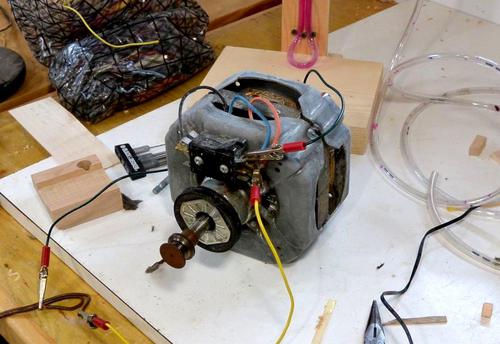 This project was mostly for the fun of experimenting, it has no real purpose.
This project was mostly for the fun of experimenting, it has no real purpose.
 This project was mostly for the fun of experimenting, it has no real purpose.
This project was mostly for the fun of experimenting, it has no real purpose.
I bought a dust collector for $150 from Busy Bee, and looking at it, I figured the blower design wasn't optimal. I also needed a blower to blow some air through a wood stove, so that got me playing around with blower design.
I decided to experiment with an old dryer motor that I had kicking around. This motor is not very powerful and only 1750 RPM.
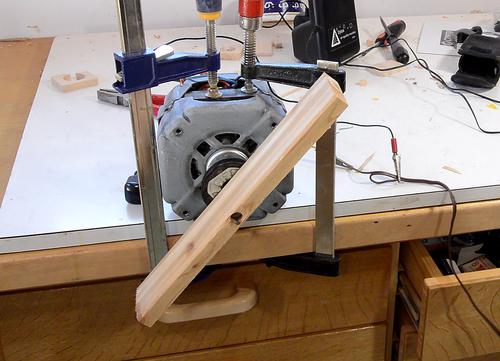 With my previous blower design experiments,
I had a hard time sizing the impeller so the motor could spin it well. I figured
a paddle with the same width and depth as the impeller, and spinning in free air might present
a similar load as the impeller. So I attached a 34 cm long piece of wood and, surprisingly,
the motor was able to spin it quite nicely, consuming 390 watt (vs. 158 watts
no-load power draw). I don't know anything about the motor's power rating,
but I was pretty sure I was well within it's load limit.
With my previous blower design experiments,
I had a hard time sizing the impeller so the motor could spin it well. I figured
a paddle with the same width and depth as the impeller, and spinning in free air might present
a similar load as the impeller. So I attached a 34 cm long piece of wood and, surprisingly,
the motor was able to spin it quite nicely, consuming 390 watt (vs. 158 watts
no-load power draw). I don't know anything about the motor's power rating,
but I was pretty sure I was well within it's load limit.
I also shot video at 30 frames per second. At 1800 rpm, the motor should also turn 30 times per second. Looking at the strobe-effect, the paddle looked like it was turning backwards at 1 turn per second, so the motor was spinning around 1740 RPM. Most four-pole induction motors (with 60 Hz mains) run around 1750 RPM fully loaded, so this seemed about right.
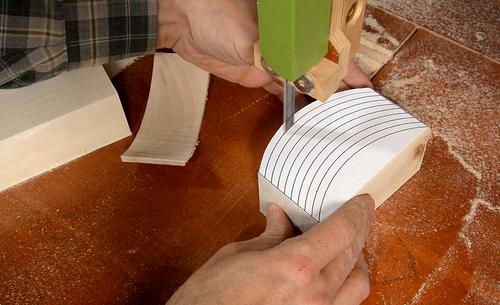
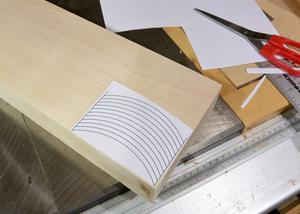 From previous experiments, I knew
that an impeller with backward-curved vanes would be the most efficient.
From previous experiments, I knew
that an impeller with backward-curved vanes would be the most efficient.
I cut the curved vanes out of a solid block of maple on the bandsaw. I laid out the cut lines in CAD and printed that out so I wouldn't have to worry about inaccuracies in my marking.
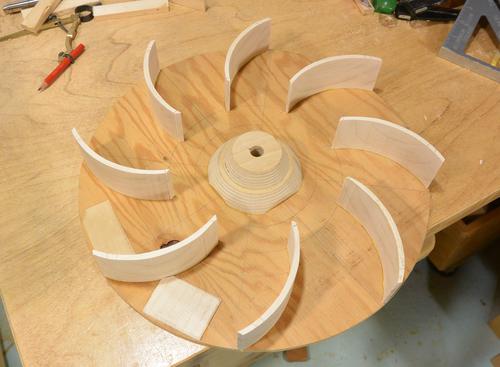 Curved vanes glued on the rotor. The lighter rectangles on the rotor are extra pieces of wood I glued
on to balance it.
Curved vanes glued on the rotor. The lighter rectangles on the rotor are extra pieces of wood I glued
on to balance it.
I checked the balance by placing the rotor shaft hole over a marble and checking which way it would tip.
The hub is two circular pieces of Baltic birch (cut with the bandsaw table tilted), glued onto the rotor.
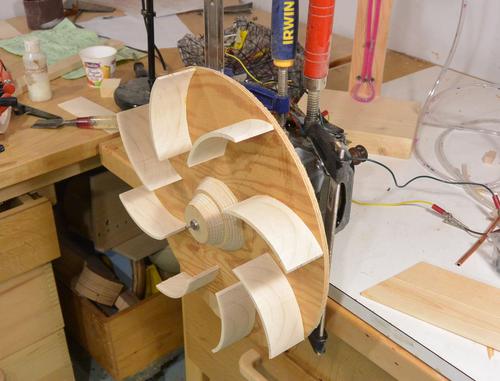 Testing the partially completed rotor on the motor. It spun nicely, no disaster.
Spinning up a big disk at 1750 RPM is much less frightening than
spinning up a big rotor at 3500 RPM.
Testing the partially completed rotor on the motor. It spun nicely, no disaster.
Spinning up a big disk at 1750 RPM is much less frightening than
spinning up a big rotor at 3500 RPM.
Note that the rotor spins counter clockwise, as seen here. It's counterintuitive, but impellers are the most efficient when the vanes curve away from the direction of rotation. more on that.
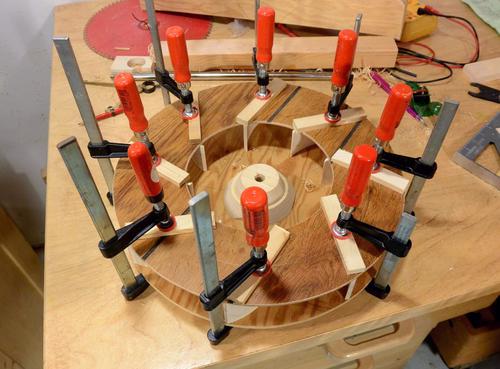 Second layer glued on. Using recycled paneling. It's just an experiment, so no point
in wasting good plywood.
Second layer glued on. Using recycled paneling. It's just an experiment, so no point
in wasting good plywood.
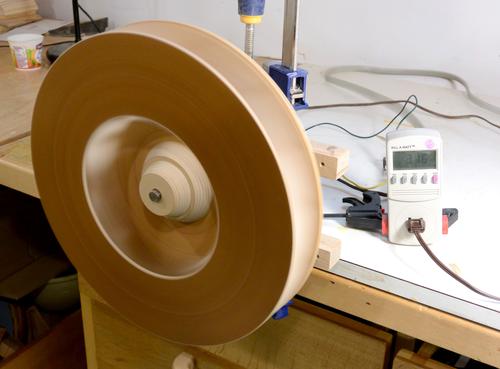 Testing the rotor spinning in free air. Power consumption was 316 watts,
less than spinning the single paddle on the motor shaft.
Testing the rotor spinning in free air. Power consumption was 316 watts,
less than spinning the single paddle on the motor shaft.
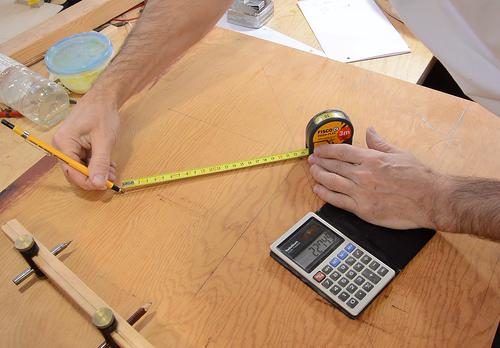 With the rotor working, I needed a spiral shaped housing to direct the air.
I laid this out, with the housing spiraling from about 19 cm to 26 cm in radius.
With the rotor working, I needed a spiral shaped housing to direct the air.
I laid this out, with the housing spiraling from about 19 cm to 26 cm in radius.
I started by drawing eight "spokes", and increased the radius for each spoke by equal increments.
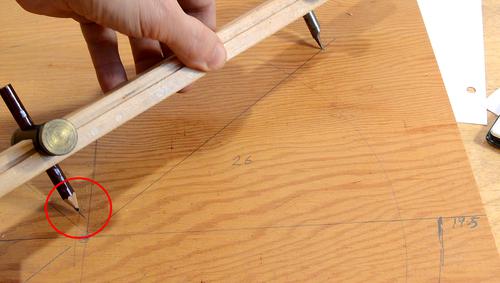 I approximated the eight segments of the spiral as circular arcs. I did this by setting
my beam compass to a radius half-way between the two radii I wanted to span. Then I drew
a small arc segment from the two marked radius points in towards the center. Where the arcs
intersect is the center of the circular arc segment.
I approximated the eight segments of the spiral as circular arcs. I did this by setting
my beam compass to a radius half-way between the two radii I wanted to span. Then I drew
a small arc segment from the two marked radius points in towards the center. Where the arcs
intersect is the center of the circular arc segment.
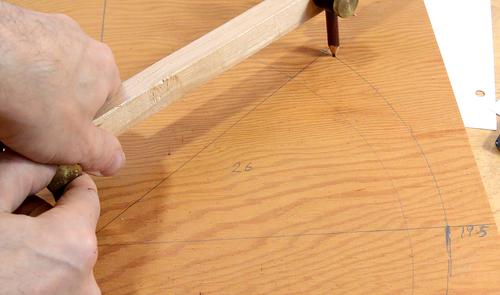 So then it was just a matter of flipping the beam compass around and drawing the 45-degree arc.
So then it was just a matter of flipping the beam compass around and drawing the 45-degree arc.
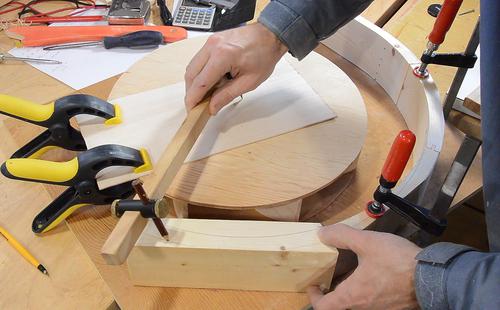 I made the curved housing by cutting curved arcs out of pieces of 2x4 lumber. I used roughly the
same method as before to mark the arc on the pieces....
I made the curved housing by cutting curved arcs out of pieces of 2x4 lumber. I used roughly the
same method as before to mark the arc on the pieces....
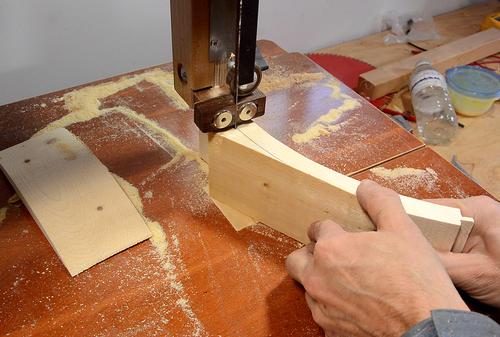 ... then cut them out on the bandsaw.
... then cut them out on the bandsaw.
In retrospect, it would have been much easier if I just made a cut-out shape of the spiral housing profile and traced that both on the back plywood and the enclosure pieces.
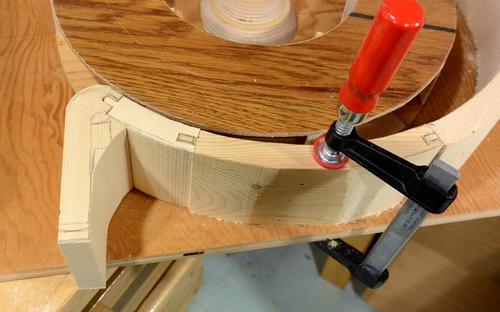
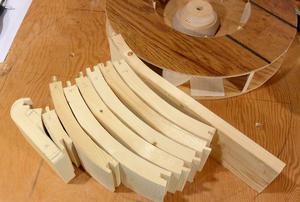 I put a tongue and groove on either end of the pieces to help join them up. I cut the tongue
and grooves freehand on the bandsaw. This worked surprisingly well.
I put a tongue and groove on either end of the pieces to help join them up. I cut the tongue
and grooves freehand on the bandsaw. This worked surprisingly well.
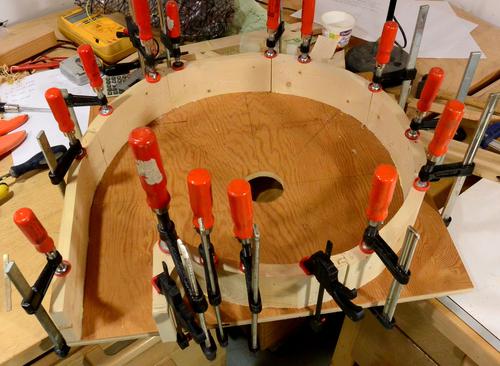 With all the pieces cut, I sanded the inside smooth, then glued them all to
the back of the enclosure and to each other.
With all the pieces cut, I sanded the inside smooth, then glued them all to
the back of the enclosure and to each other.
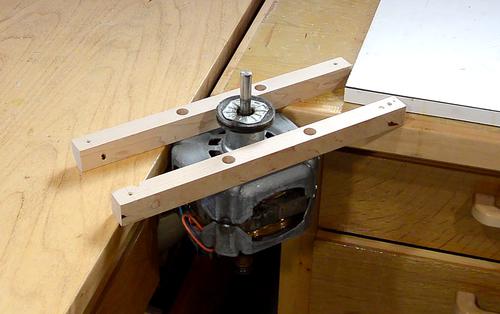 The motor had four holes in the front. I tapped these with a 1/4" thread to make
mounting holes. Two pieces of wood help to hold the motor and reinforce the back of
the enclosure.
The motor had four holes in the front. I tapped these with a 1/4" thread to make
mounting holes. Two pieces of wood help to hold the motor and reinforce the back of
the enclosure.
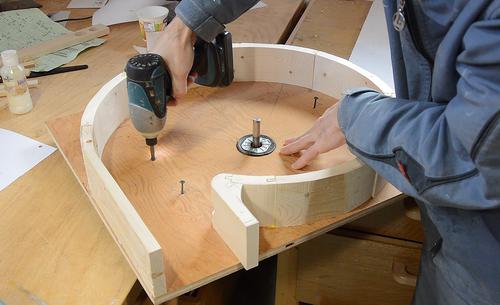 Screwing the enclosure to the motor mounts.
Screwing the enclosure to the motor mounts.
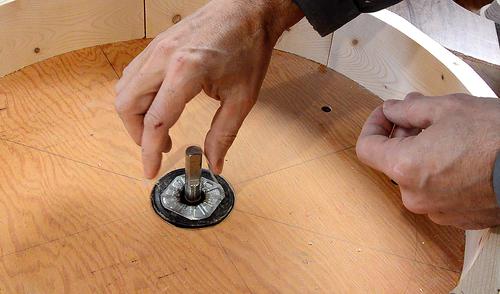 The 1/2" hole in the rotor was a bit of a loose fit for the motor's 1/2" shaft.
So I put a strip of polyethylene over the shaft before pushing the rotor on.
The 1/2" hole in the rotor was a bit of a loose fit for the motor's 1/2" shaft.
So I put a strip of polyethylene over the shaft before pushing the rotor on.
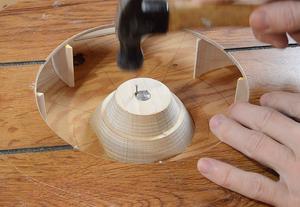 A brad nail driven in on the flat side of the shaft keeps the shaft from
spinning inside the rotor, for the time being.
A brad nail driven in on the flat side of the shaft keeps the shaft from
spinning inside the rotor, for the time being.
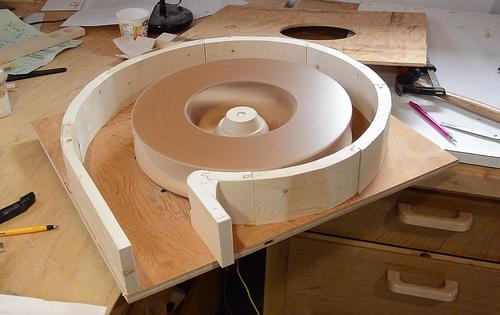 Spinning it up for the first time!
Spinning it up for the first time!
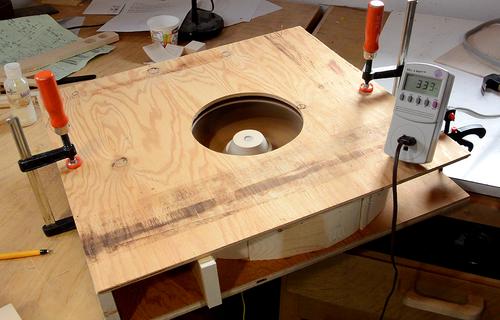 Next, with the cover in place.
Next, with the cover in place.
I figured containing the airflow would reduce power consumption a bit, but it was the same as with no cover, and slightly more than the impeller spinning in free space. I was surprised that the impeller would require more power to spin inside the enclosure.
At any rate, it was still less power than just the paddle spinning on the motor in free space, so I think the paddle is a good way to check if a motor is powerful enough for a given sized impeller.
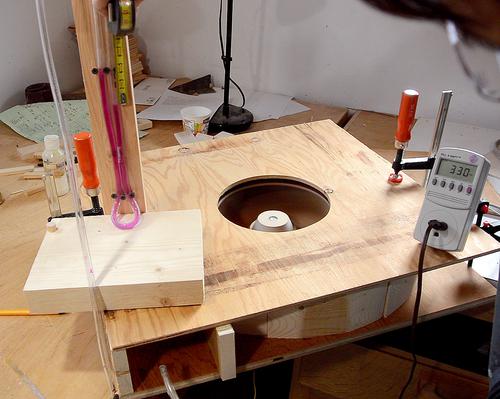 Checking air flow via Pitot tube pressure (note piece of hose held in front of blower output).
At 4 cm of pressure, that worked out to about 25 meters per second (about 90 km/hour). That
works out to about 11.5 cubic meters per minute of total airflow, or 430 CFM.
Checking air flow via Pitot tube pressure (note piece of hose held in front of blower output).
At 4 cm of pressure, that worked out to about 25 meters per second (about 90 km/hour). That
works out to about 11.5 cubic meters per minute of total airflow, or 430 CFM.
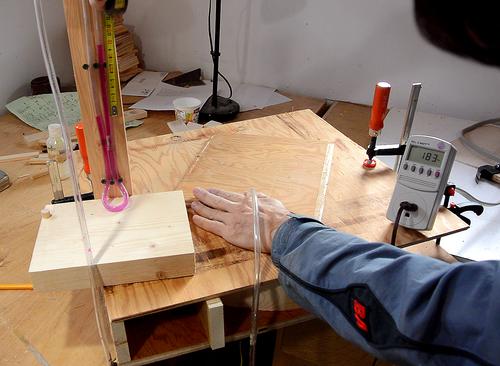 Blocking the inlet, I got 95 mm of static pressure (or suction). Quite a bit more than
my calculations would suggest for a 34 cm disc spinning at 1750 RPM. I was expecting about 70 mm.
I think there is a lot of air that spins around the impeller, and that adds to the effective
size of the spinning disk of air.
Blocking the inlet, I got 95 mm of static pressure (or suction). Quite a bit more than
my calculations would suggest for a 34 cm disc spinning at 1750 RPM. I was expecting about 70 mm.
I think there is a lot of air that spins around the impeller, and that adds to the effective
size of the spinning disk of air.
With no airflow, the motor's power draw is just 183 watts, just 25 watts over the 158 watts for the motor running with nothing attached.
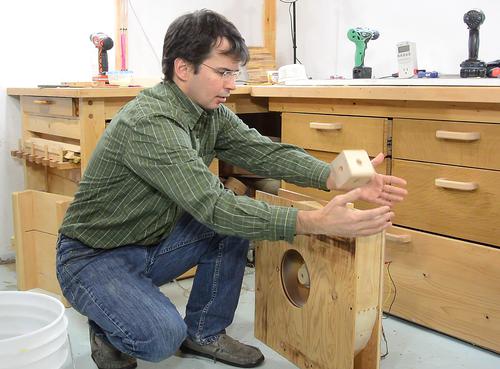 I really have no use for this blower. It's far too powerful to blow air in the back of
a wood stove, but with 95 mm of static pressure, it's not enough to pull air through a length
of ducting and filter. It's MUCH more powerful than the blower in a clothes dryer would be,
but that motor would also be spinning the drum in a dryer.
I really have no use for this blower. It's far too powerful to blow air in the back of
a wood stove, but with 95 mm of static pressure, it's not enough to pull air through a length
of ducting and filter. It's MUCH more powerful than the blower in a clothes dryer would be,
but that motor would also be spinning the drum in a dryer.
I was surprised how powerful the dryer motor is, possibly as much as 1/3 hp. I'm sure it could easily power a bandsaw as long as it's not used for resawing.
It might still have some uses though, maybe for a dust collector that is designed to sit right next to a machine, or one that is designed to only pull away the fine airborne dust from a sander without trying to pull coarse shavings through a length of ductwork and cyclone.
I ended up using the blower I built here with my fiberglass filter
experiments, later as my Wasp sucking
machine XL, as a
welding smoke extractor and finally for a
dust collector.
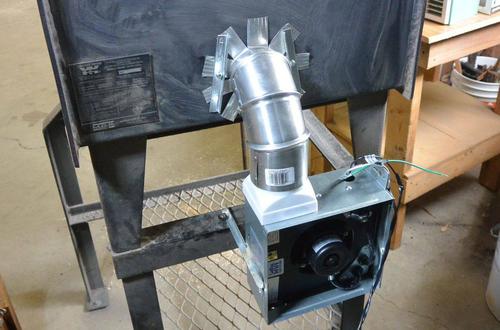 As for the wood stove blower
As for the wood stove blower
The blower I built was far too big and powerful, and being made of wood,
I'd need to connect it with a length of ductwork to keep it away from the stove.
Proper wood stove blowers are surprisingly expensive, $200 and up
(more than a dust collector!).
So I bought a bathroom fan for $26, added a $3 dryer vent elbow, welded on some mounting
rails, and used that.
I'm sure the crowd that believes two sticks rubbed together will catch fire will want to inform me that this is dangerous. These blowers don't blow into the actual fire box, just into an internal cavity to bring out more heat. And the back wall of the stove doesn't even get that hot, even without a blower. The electrical hookup here is temporary - didn't have a strain relief with me when I installed it.
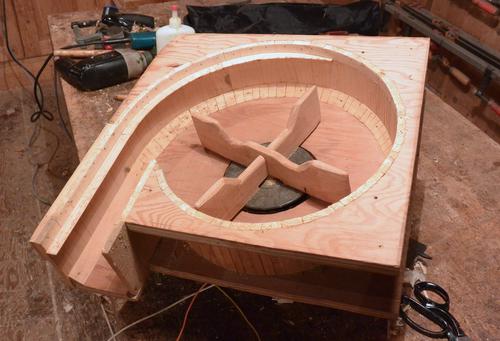 Another way to make the housing
Another way to make the housing
Digging thru the attic above my dad's shop, here's a blower I built
in 1987. The spiral housing on this one is out of a lot of small pieces of
wood parallel to the axis. Quite a lot of work, but you can build it this way without
a bandsaw.
The blower was for sucking shavings from the 20" thickness planer. It wasn't meant to be a dust collector, just to suck the shavings from the player and throw them to the side instead of having them shot at me when I pulled the boards out of the planer. But it wasn't powerful enough for that, and the planer would plug up with shavings from time to time. Looking at it now, I think it would have done the job if I used a 3500 RPM motor instead of a 1750 RPM motor.
Things I used this blower for:
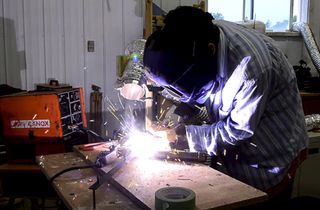 Welding smoke extractor (video only)
Welding smoke extractor (video only)
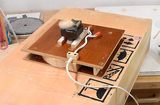 Mini dust collector
Mini dust collector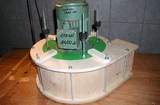 Ryszard's dust collector
Ryszard's dust collector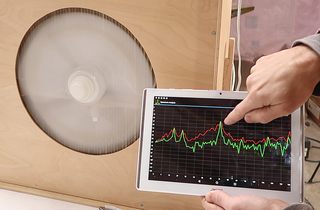 Measuring RPM with a spectrum analyzer app (video only)
Measuring RPM with a spectrum analyzer app (video only)